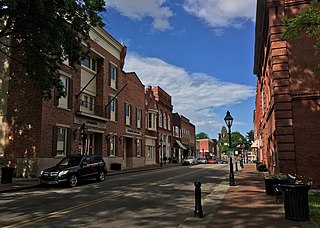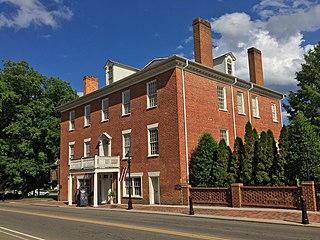
Hawkins County is a county located in the U.S. state of Tennessee. As of the 2020 census, the population was 56,721. Its county seat is Rogersville. Hawkins County is part of the Metropolitan Statistical Area, which is a component of the Johnson City-Kingsport-Bristol, TN-VA Combined Statistical Area, commonly known as the "Tri-Cities" region.

Sharon Springs is a village in Schoharie County, New York, United States. The population was 558 at the 2010 census. Its name derives from the hometown of the first colonial settlers, Sharon, Connecticut, and the important springs in the village. Sharon Springs, Kansas, likewise was settled by former residents of this upstate New York village.

Rogersville is a town in and the county seat of Hawkins County, Tennessee, United States. It was settled in 1775 by the grandparents of Davy Crockett. It is named for its founder, Joseph Rogers. Tennessee's second oldest courthouse, the Hawkins County Courthouse, first newspaper The Knoxville Gazette, and first post office are all located in Rogersville. The Rogersville Historic District is listed on the National Register of Historic Places.

Sevierville is a city in and the county seat of Sevier County, Tennessee, United States, located in eastern Tennessee. The population was 17,889 at the 2020 United States Census.

George Leonard Berry was president of the International Printing Pressmen and Assistants' Union of North America from 1907 to 1948 and a Democratic United States Senator from Tennessee from 1937 to 1938.

Bean Station is a town split between the counties of Grainger and Hawkins in Tennessee, United States. As of the 2020 census, the population was 2,967. It is part of the Kingsport and Knoxville metropolitan statistical areas.
The Rogersville Review is a twice-weekly newspaper publishing in Rogersville, Tennessee, United States.

Hale Springs Inn, built in 1824 on the Courthouse Square in Rogersville, Tennessee, was the oldest continuously-operated Inn in Tennessee. It is listed as a contributing property of the Rogersville Historic District.

Hot Lake Hotel is a historic Colonial Revival hotel originally built in 1864 in Hot Lake, Union County, Oregon, United States. The hotel received its namesake from the thermal spring on the property, and operated as a luxury resort and sanitorium during the turn of the century, advertising the medicinal attributes of the mineral water and drawing visitors worldwide. It is also the first known commercial building in the world to utilize geothermal energy as its primary heat source.

Durham's Chapel School, also known as Durham's Chapel Rosenwald School, is a former school for African-American children located in Gallatin, Tennessee, that is listed on the National Register of Historic Places.

Togus VA Medical Center is a facility operated by the United States Department of Veterans Affairs in Chelsea, Maine. The facility was built as a resort hotel, and housed Union veterans of the American Civil War prior to being converted to a veterans hospital. It was the first veterans facility developed by the United States government.

Amis House is a pioneer settlement in Hawkins County, Tennessee near Rogersville, built in 1780–2 by Thomas Amis, the father-in-law of Rogersville founder Joseph Rogers.

The Hawkins County Courthouse is the seat of county government for Hawkins County, Tennessee, United States, located in the city of Rogersville. It was built in 1836, it is one of six antebellum courthouses still in use in Tennessee, and it is the second oldest courthouse still in use in the state.

Price Public Elementary School, now known as Price Public Community Center and Swift Museum, is a former African-American school in Rogersville, Tennessee. It currently serves as a community center and home of the Swift Museum. The school was listed on the National Register of Historic Places in 1988.

The Rogersville Historic District is a historic district in Rogersville, Tennessee, the county seat of Hawkins County. It is both a local historic district and a National Register of Historic Places historic district.

Tennessee marble is a type of crystalline limestone found only in East Tennessee, in the southeastern United States. Long esteemed by architects and builders for its pinkish-gray color and the ease with which it is polished, the stone has been used in the construction of numerous notable buildings and monuments throughout the United States and Canada, including the National Gallery of Art, National Air and Space Museum, and United States Capitol in Washington, D.C., the Minnesota State Capitol, Grand Central Terminal in New York, and Union Station in Toronto. Tennessee marble achieved such popularity in the late-19th century that Knoxville, the stone's primary finishing and distribution center, became known as "The Marble City."

St. Marks Presbyterian Church is a historic African-American Presbyterian church in Rogersville, Tennessee. Its building was added to the list of National Register of Historic Places in March 10, 2006.

State Route 94 is an 8.1-mile-long (13.0 km) state highway in rural northern Hawkins County in the northeastern portion of the U.S. state of Tennessee. SR 94 serves as a connector from SR 66 to SR 70 and provides access to the former town of Pressmen's Home.

The Woodmen of Union Building is a historic commercial building at 501 Malvern Avenue in Hot Springs, Arkansas. It is a four-story structure, built mainly out of brick and ceramic blocks, although its southeastern section has upper levels with wood framing and finishing. Its main facade has an elaborate projecting entrance portico, with the entrance set in an elliptical-arch opening supported by fluted pilasters. The interior retains significant original features, including a bank vault, marble wainscoting, and a 2,500-seat auditorium. It was built in 1923-24 for the Supreme Lodge of the Woodmen of Union, an African-American social organization, which operated it as a multifunction bathhouse, hotel, hospital, bank, and performance venue. It was purchased in 1950 by the National Baptist Association.

Tate Springs was a historic world-class luxury resort complex located on U.S. Route 11W in Bean Station, Tennessee, United States. Known for its mineral spring water shipped internationally, it was considered to be one of the most popular resorts of its time in the Southern United States, and was visited by many wealthy and prominent families such as the Ford, Rockefeller, Firestone, Studebaker, and Mellon families.





















